This is not about us drifting along; it is about “drift seeds.” We never found a single one on our first visit to the Abacos, but Al’s discovery of one sea bean at Green Turtle Cay within the first two days of our arrival, changed our fortunes. Finding a sea bean is a sign of good luck, a good omen. Little did we realize how this first find would become a new beachcombing obsession for us, adding to the sea glass, shells and conchs, and driftwood that we acquire along the way. It sure is nice to have a larger “hold” in the boat for storing our treasures.
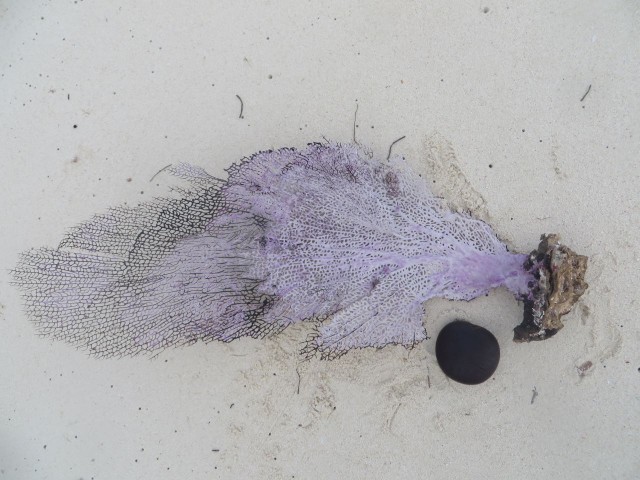
Our cruising friends showed us their sea bean finds on our first trip, but our eyes never seemed to notice any. This year, that first sea bean had us hooked and quickly trained our novice eyes, as well as hooking our curiosity (mine, for sure.) I learned that “sea beans” is a generic common name for these gems, and “drift seeds” is a more global and inclusive term. “Drift” is a very apropos name. Most of these seeds and beans are from vines and trees that grow along the tropical shores and rainforests all over the world.
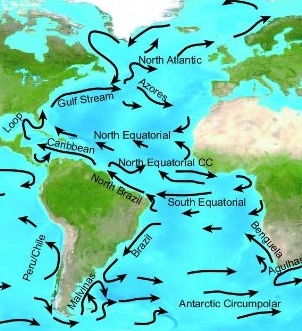
They fall into waterways and drift through inlets and bays, reaching the sea where they travel with the ocean currents until washing up upon a beach somewhere, even thousands of miles from their “homeport.”
The buoyant beans and seeds are held afloat by internal air pockets and are protected by their hard outer shells. World travelers!
The wrack line is the line of debris left on the beach by high tide. Seaweed, kelp, assorted natural debris that floated in on the tide, as well as man’s debris in the form of plastic bits and other trash.
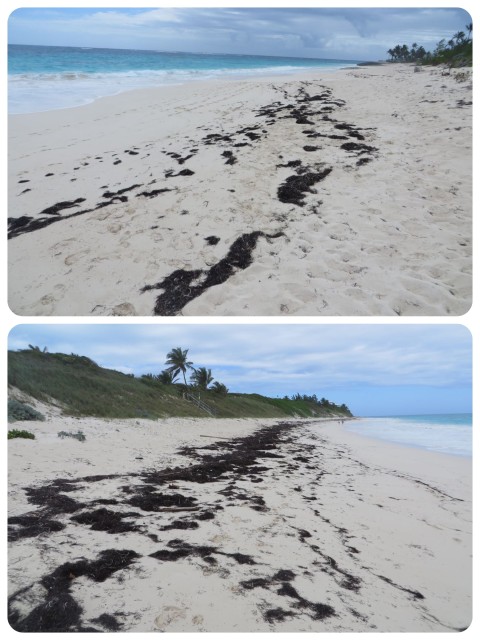
Until we started searching, both on the beach and on the internet, I had no idea how many people were obsessed with sea beans. A quick google search unearthed (unbeached?) lots of information and websites dedicated to drift seeds/sea beans. If you get hooked like we did, you can check the links below, or even attend a sea bean symposium (last one was October 2015 in Cocoa Beach, FL) or read the triennial newsletter, “The Drifting Seed.”
- Sea Bean – Best and most inclusive site for information
- The Drifting Seed newsletter (1995- 2015 online)
- Beach Beans – a site that sells sea beans
- BeachBeans blogspot – John Batchelder’s blog from 2008-2011
- WaynesWord “an online textbook of natural history, Palomar College
- Steve Asbell’s personal blog with a post on his sea beans
This blog post of mine is about the sea beans we found this winter in the Abacos.
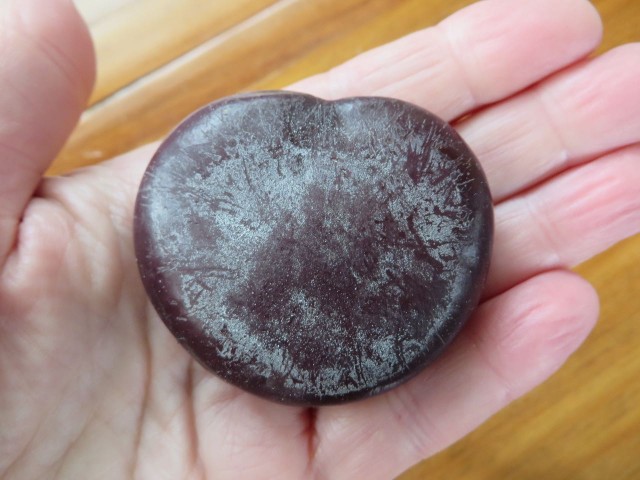
The sea heart (Entada gigas), native to Central America, the Caribbean, northern South America, and Africa. Sea hearts originate in huge, hanging bean pods, up to six feet long. They are impervious to salt water, even after years of drifting in the ocean waters. Sailors carried sea hearts as good luck charms to protect them from sickness and to ward off the evil eye. It is said that a sea heart (also known as fava de Colom) inspired Christopher Columbus to set out in search of lands to the west.
Supposedly, sea hearts are second to brown hamburgers as the most common of all beach-found sea-beans. We did not find this to be true. We found more sea hearts than any other kind of sea bean or drift seed.
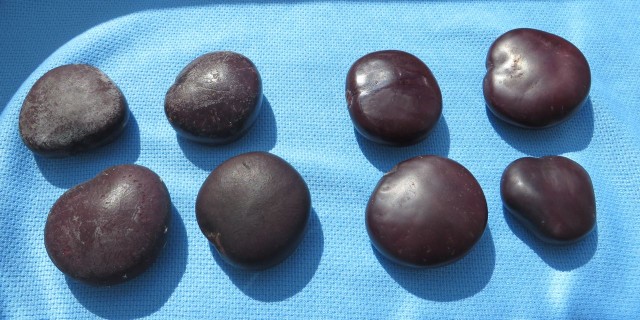
Polishing sea hearts is quite a task with several steps and lots of time.
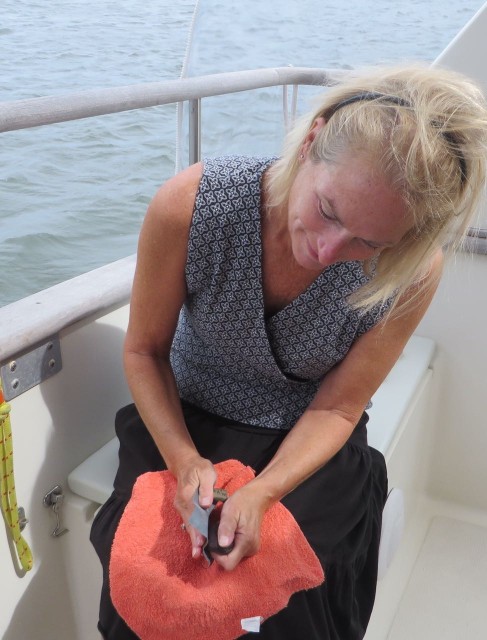
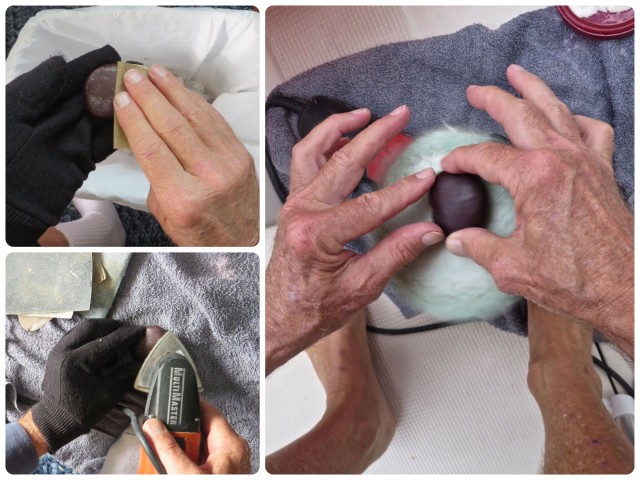

Hamburger beans, said to be the most common of all beach found sea beans, are sometimes considered to be “true sea beans.” Our experience says otherwise – finding a hamburger bean was unusual. We were thrilled to find a brown one and then a red one.
There are hundreds of varieties in varying shades of brown, red, and brindle growing in tropical regions around the globe. Nowadays they are carried for good luck and protection against the “evil eye.”

Brown Hamburger, Mucuna sloanei , the most common of all beach-found sea-beans are more ball-shaped than other species which are flat in comparison. Tropical Africa, South America, Mexico, Florida and the Caribbean.
Red Hamburgers Mucuna urens are found less often than brown hamburgers. They are flatter and have more color variations from light beige to deep red.
Sea purse – Dioclea reflexa Coveted by collectors, sea purses are one of the rarest and most colorful of all sea beans found on any beach. Distinct color variations range from butterscotch to solid black. Originally from Asia, these beans have drifted to islands in the Caribbean and Central and South America, reproducing there. The circular hilum along the edge of these resembles a zipper, giving it the name “sea purse.” They have thick, protective shells which, enable them to survive for years at sea in the salt water.
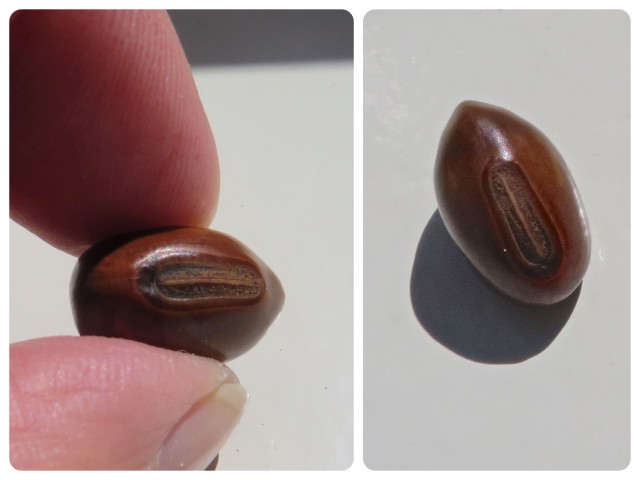
Nickernuts or nickar nuts are used as marbles (Dutch word knicker for clay marbles) in the strategy games of African mancala or Caribbean’s “Island Waurie.”
The same day I found the brown nickarnut, I also picked up a funny looking bean or seed. With the help of “The Little Book of Sea Beans and Other Beach Treasures“, I identified it as a Starnut palm (Astrocaryum spp.) The Rainforest Garden Blog stated, “Some, like the starnut palm, are ridiculously tropical and exotic.” Very cool. I was excited to add this to our tiny collection of sea beans.

Sea coconut (Manicaria saccifera), is also known as “golf ball” because it is the size and shape of a round golf ball. It is not a real coconut, but it is a palm tree.The sea coconut is a tall, unusual palm with leaves nearly 30 feet long. It grows in the Amazon basin, on the island of Trinidad, and on the Caribbean coasts of Central and northern South America spottily. We found quite a few sea coconuts, but the outer skin would soon crack and crumble. They don’t look very attractive, and yet there are photos of how pretty they look after polishing. We aren’t sure how they can be polished with that crackling outer shell.
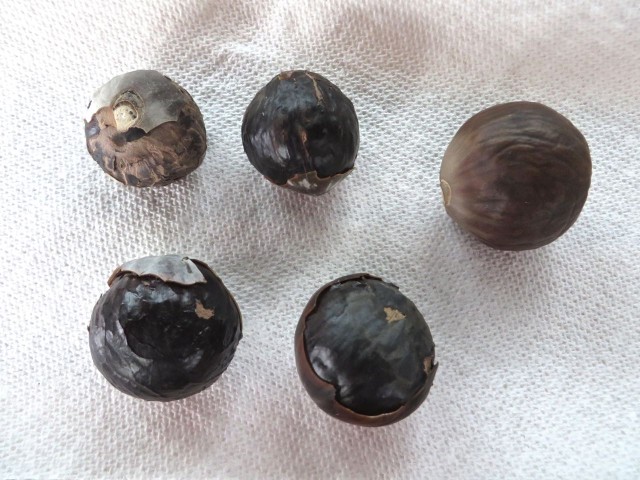
The mahogany or madeira tree is native to southern Florida, Florida Keys, Cuba, Bahamas, Hispaniola, Jamaica. I first noticed strange wooden-looking pods scattered about on the grounds of the Lighthouse Gift Shop when I worked there. They were very interesting looking so I gathered a few up. I had the opportunity to show it to a local person who informed me it was from the madeira tree also known as the mahogany tree.
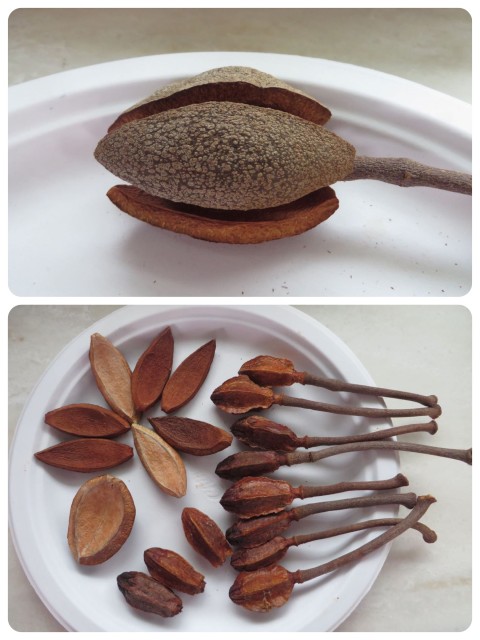
Royal Poinciana is a species of flowering plant, noted for its fern-like leaves and flamboyant display of red flowers. When we found these pods along the side of the road on Treasure Cay, the plant was not in its “flamboyant” phase. The pods were dried and woody on the ground or hanging limply from the tree.

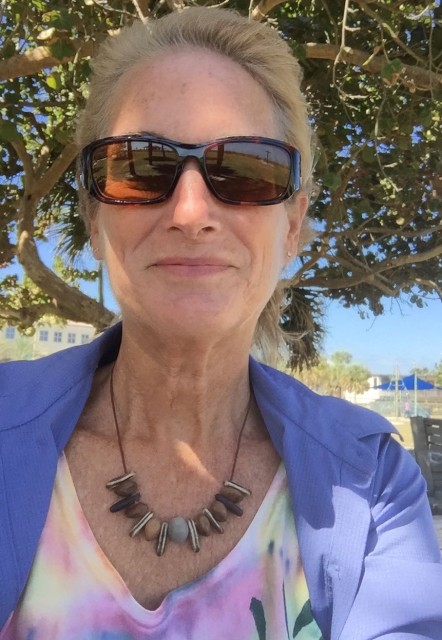


Cathy Benson
This is way cool. Who knew? Certainly not me! Thanks for the enlitenment. BTW, Susan wants to go to Mariachi for dinner! So see yall there. Xxoo
Scott
I have been finding them along the east coast of NSW Australia for years. I know them as monkey nuts and only read that there called hearts of the sea. Beautiful
George
I have lived in South Florida (Hollywood, North Miami Beach, Ft. Lauderdale and so on) for 20 years now — during which I have found TWO, exactly two, hamburger beans. The first was quite large, about 1 3/4 inches across and at the time I had no idea how uncommon they were. The second, a red hamburger bean about the size of a nickel, I found four days ago.
Granted I’m on the east coast in populous areas where you’d expect the beach to be more picked over. Even so, just two hamburger beans in 20 years leads me to believe they aren’t exactly common. I was totally delighted by my find, even more so now that I know what it is!
I’d encourage everyone who’s sorting through the wrack line looking for natural treasures to spend some time gathering up the plastic shards, beer bottle caps, cigarette filters, tangles of fishing line and all the other garbage that washes up. I’d like to believe that picking up and disposing of a lot of garbage on the beach gives me better beachcombing luck… Plus it just feels good to take some litter off the beach.
Thanks so much for this awesome article!
Nancy Tompkins
Thank you for identifying my find.
I’ve heard about sea beans, now I know I have one and what kind!
July 2023 Galveston Island, Texas
Starnut Palm
watsons
Special find!
Mars
Nancy, you were probably there when we were last year too. I just found a bean and a sea coconut on the beach in Corpus for this year’s beach trip. Hope you have a good summer
Joel
I found on the beach in Fl. We didnt know what it was so I cut it in half with a saw. Its cross-section resembled that of a coconut. A 2 mm white solid and a hollow core. Have you ever cut one?
watsons
Never cut one open! Thanks now I know what it looks like inside!
Lori
I have one on my table we picked up in Mexico!! I had no idea what it was. It’s a sea bean. Awesome to read about this. Also have several black “hamburgers”. I thought they were called deer eyes. Because they look like a deer eye. Thanks for sharing.
Michele
Once we discovered sea beans we became obsessed with finding them on the beaches in the Bahamas. There is nothing better than a natural treasure that you find yourself. 😉
Horsing Around on Cumberland Island (Day 168) – Sailing Belle Bateau
[…] her collection of sea beans, and whether we could find any on this beach. See Michele’s blog: http://blog.kindred-spirit.net/2016/03/15/drifting-along-drift-seeds-and-sea-beans/. Funny thing though. Where sea beans typically collect on beaches—at the upper edges of the […]
Cori
Beautiful necklace!!! Love the blog
Peggy Bjarno
Very cool! I think I could easily become addicted too. Cool beans. . . 😀